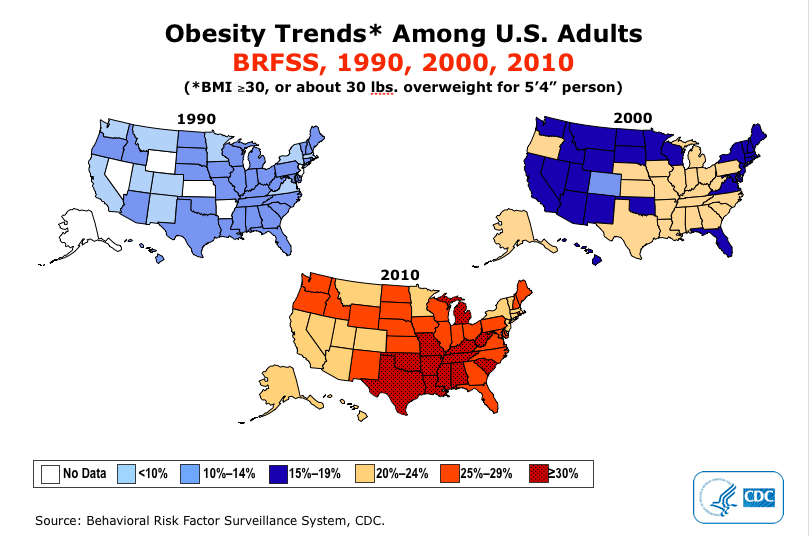Exactly; why do we get fat?
We all want to do the right thing, feel and look great, have more energy… We have listened to our doctor who says we have to lose weight for our heart, blood pressure, cholesterol, diabetes… Nothing’s working; what do we do?
 Weight loss: what are we missing?
Weight loss: what are we missing?
Most of us at one time or another have tried calorie-counting, portion control, and despite all we did to deprive and control, we’ve felt the humiliation and self-invalidation of failing…
The obesity epidemic: Why?
A piece of history: Between 1980 and 2000, obesity rates doubled in the United States. Why we get fat? The food environment dramatically changed with manufacturers embracing impulse-marketing strategies:
 they bought prominent shelf space placing tempting, high-calorie foods and beverages at the end of aisles in supermarkets and at cash registers;
they bought prominent shelf space placing tempting, high-calorie foods and beverages at the end of aisles in supermarkets and at cash registers;- they installed snacks and sugary drinks in businesses that don’t sell food—hardware stores and gas stations began pushing snacks at the checkout counter and mushroomed into convenience stores; schools raised money (and lowered learning rates) with sugary vending machines;
- and not only did the amount of advertising mushroom but junk food allured children with toys and depicted healthy, vibrant people who are slim and active enjoying Coca-Cola or Lays.
 by 2007, children and teenagers saw 30-50 hours of commercials annually for foods nutritionists agree we should eat less of: more than 40 percent are ads for candy, snacks and fast food. Missing? fresh fruit, vegetables, poultry or seafood.
by 2007, children and teenagers saw 30-50 hours of commercials annually for foods nutritionists agree we should eat less of: more than 40 percent are ads for candy, snacks and fast food. Missing? fresh fruit, vegetables, poultry or seafood.
[cryout-pullquote align=”left|center|right” textalign=”left|center|right” width=”33%”]“20 years trapped in obesity (society blamed me personally for it) but I did everything I was suppose to do. I now live well at a normal weight and athletic now. I feel so much better. I wish I’d had this guidance years ago.” –SM
“My metabolic disorder diabetes 2 is well under control with no medication after about 9 months. Lots of good protein (like fish) and fats, NO sugar, No grain, I needed the right tools and am living proof it works. Thank you” –RL[/cryout-pullquote]
These food cues and triggers are carefully designed so we eat when we’re not hungry. Worse even than that, since the ads depict only fit and trim people consuming sugary treats, the ads imply weight gain must not be the fault of these products but something else—like one’s genes or lack of self-control.
So, what is the truth about weight-related health?
In short, the fact that obesity and diabetes are running rampant in our lifetimes and destroying the health, happiness and even the abilities of our children, that fact alone says either the science or the nutrition advice on why we get fat must be wrong. Diabetes has tripled since 1980 in the United States.
The short answer—the fact—is that whatever makes us fat also causes heart disease, type two diabetes, cancer, inflammation, autoimmune and according to a recent study even autism.
And worse—being fat also causes those things.
What changed? A lot of things: more convenience foods meant more food dyes and colors to make the profit-driven cheap ingredients look better, food additives to enhance flavor—the biggest flavor additives being sugar, preservatives so food products can stay longer on the shelf… and an enormous marketing campaign that tells us fat is bad, really bad; carbohydrates are good—eat whole grains; and no mention of the difference between plant-based carbohydrates—meaning growing vegetables—and grains and definitely no mention of sugar except to hook us like any other narcotic (because sugar is a narcotic).
If you are looking for a quick-fix, weight loss answer…
There are a lot of people who will tell you what you want to hear.
I am not going to be one of those as misinformation is behind this epidemic. 30 years ago 1-2 children in a classroom were obese; today, 1-2 children are not overweight—or have chronic inflammation, asthma, have developed type 2 diabetes at earlier ages (it used to be called “adult onset” but was renamed when commonly diagnosed at the same young ages as the type 1 genetic problem).
Please watch this video by Dr. Robert Lustig from UCLA whose career as a pediatrician is all about helping us understand the problem we face.
Most parents (and I’m sorry to have to say this) actually think they *must* provide sugary treats for everything from playing a sporting game to simply spending a day together. Or that a little bit isn’t bad—and what is “a little bit” is not little compared with just a generation ago.
But it isn’t just sugar—that’s the key trick—it is also all those things that quickly convert to sugar: starchy, grain-based foods.
So please read this carefully as it may help you deal with the next three days of sugar and carb cravings as you reform your fridge and add more veggies to your meals:
When people lose weight by cutting calories, the first thing that happens is their metabolism (the amount of calories burning at rest) slows down. This means not only do you fight hunger and cravings constantly to maintain low weight, but you also don’t burn as much—this is called “metabolic compensation”.
Now your body goes through a plateau—it stops losing weight despite the cut calories because its burn rate has slowed down.
And, for the rest of your life, if you count calories, dutifully portion control, and obediently follow recommendations to eat whole grains and lean protein, you may or may not keep the weight off. Wow. Failure… sigh…
How do we achieve our ideal weight?
In 2012, Dr. Ludwig of Boston Children’s Hospital revealed breakthrough information (I just have to say this: women have known this for centuries…) Starchy carbohydrates make you fat.
Quality food, not calories, makes all the difference in losing weight:
Dr. Ludwig cut calories until people lost 10-15 percent of their weight. Then he rotated them so they spend one month on each three different diets; each diet was an equal amount of calories but from different foods.
The weight loss diet comparison:
Diet #1: whole grains, fruits, vegetables, lean sources of protein (aka the USDA Food Pyramid and “Heart Healthy” guidelines).
Diet #2: low glycemic index: fewer carbohydrates in total, and those that were included were slow to be digested — from beans, non-starchy vegetables and other minimally processed sources.
Diet #3: Atkins, which is very low in carbohydrates and high in fat and protein.
Don’t they all sound, well, fine? And the envelope please: Diet #3, the Atkins group, expended more calories at rest and maintained lower weight better.
Importantly, these were the very same people in each group! When the same people were on the whole grain lean protein diet they gained weight and their metabolism slowed. When put on the Atkins diet, the same people burned 300 calories per day more, often more on Atkins than they did before the original calorie counting and “metabolic compensation.” Over the month, the Atkins group continued to move toward their ideal weight. The low glycemic index diet was somewhere in the middle.
Folks, eating fat does not make you fat—our bodies were designed to burn fat for fuel and use protein for reconstruction. Fat doesn’t cause heart disease or high cholesterol either. The other good news is that Paleo and Primal lifestyles are similar in low-carb approach to the Atkins diet (at least to phase 2) that these likely produce the same results without the Atkins diet flaws (like the saturated fat myth).
And since these were the same people on each diet, it is not possible to argue the genetic “I can’t do anything about it” story. Yes, you can—you can look great and have all the energy you want.
Join me for part 2, next week… I promise to explain all this. Meanwhile, I hope this adds value to your thinking and a spring in your step as you march past those fancy isle displays and right on over to the vegetables and grass fed butter.
Keep in touch on this blog or if I can help you in a more personal way schedule a FREE health consultation.
To your health!







